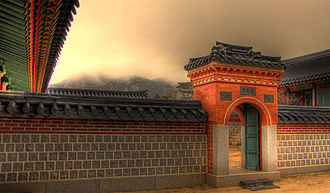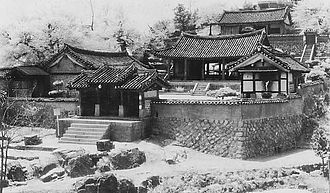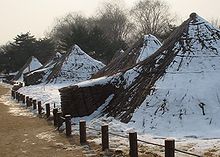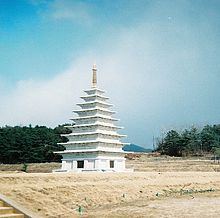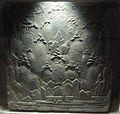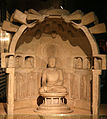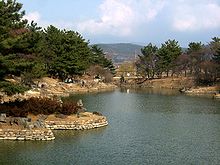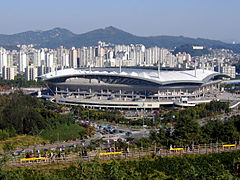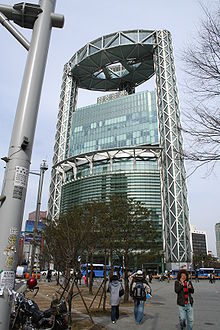- Korean architecture
-
Sungyang Seowon, an academic institute dating to the Joseon dynasty and Confucian shrine.

Korean architecture refers to the built environment of Korea from c. 30,000 BC to the present.
Introduction
From a technical point of view, buildings are structured vertically and horizontally. A construction usually rises from a stone subfoundation to a curved roof covered with tiles, held by a console structure and supported on posts; walls are made of earth (adobe) or are sometimes totally composed of movable wooden doors. Architecture is built according to the k'an unit, the distance between two posts (about 3.7 meters), and is designed so that there is always a transitional space between the "inside" and the "outside."
The console, or bracket structure, is a specific architectonic element that has been designed in various ways through time. If the simple bracket system was already in use under the Goguryeo kingdom (37 BCE–668 CE)—in palaces in Pyongyang, for instance—a curved version, with brackets placed only on the column heads of the building, was elaborated during the early Koryo dynasty (918–1392). The Amita Hall of the Pusok temple in Antong is a good example. Later on (from the mid-Koryo period to the early Choson dynasty), a multiple-bracket system, or an inter-columnar-bracket set system, was developed under the influence of Mongol's Yuan dynasty (1279–1368). In this system, the consoles were also placed on the transverse horizontal beams. Seoul's Namtaemun Gate Namdaemun, Korea's foremost national treasure, is perhaps the most symbolic example of this type of structure.
In the mid-Choson period, the winglike bracket form appeared (one example is the Yongnyongjon Hall of Jongmyo, Seoul), which, according to some authors, better suited the peninsula's poor economic situation that resulted from repetitive invasions. Only in buildings of importance like palaces or sometimes temples (Tongdosa, for instance) were the multicluster brackets still used. Korean Confucianism also led to more sober and simple solutions.
Historical architecture
Prehistoric architecture
In the Paleolithic the first inhabitants of the Korean peninsula used caves, rockshelters, and portable shelters. The remains of a portable shelter dating to c. 30,000 BC were excavated at the Seokjang-ri site in South Chungcheong Province.[1] The earliest examples of pit-house architecture are from the Jeulmun Pottery Period.[1] Early pit-houses contained basic features such as hearths, storage pits, and space for working and sleeping.
Log houses were built by laying logs horizontally one on top of one another. The interstices between the logs were filled with clay to keep the wind out. Similar houses are still found in mountainous areas as like Gangwon-do province.[2]
Elevated houses, which probably originated in the southern regions, are believed to have first been built as storage houses to store grains out of the reach of animals and to keep them cool. This style still survives in the two-story pavilions and lookout stands erected in melon patches and orchards around the countryside.[2]
In the Mumun period buildings were pit dwellings with walls of wattle-and-daub and thatched roofs.[1] Raised-floor architecture first appeared in the Korean peninsula in the Middle Mumun, c. 850-550 BC.[1]
Megaliths, sometimes called dolmens, are the burials of important and prestigious persons of the Mumun Pottery Period (1500-300 BC). They have been found in great numbers and along with stone-cist burials, megaliths and are the main examples of mortuary architecture in the Mumun. There are three types of megaliths: (1) the southern type, which is low and often a simple slab with supporting stones, (2) the northern type, which is larger and shaped much like a table, and (3) the capstone type, which has a capstone with no supporting stones. The distribution of the dolmens would imply some relation to other global megalithic cultures.
Proto–Three Kingdoms Period (circa 1st-2nd century BCE to 3rd-4th century CE)
Archaeological evidence of ondol, the Korean floor panel heating system, was found in the architectural remains of early Protohistoric.[1]
According to Chinese text Sanguo Zhi, it recorded the existence of three types of prehistoric dwellings in Korea: pit houses, log houses and elevated houses. Only the remains of pit houses have been identified, however. Pit houses consisted of a 20–150 cm deep pit and a superstructure of grass and clay supported by a tripod-like frame made of timber to provide protection from the wind and rain. Pit houses of the Neolithic period had circular or oval pits about 5–6 meters in diameter with a hearth at the center. Most of the early ones were located on hills. As these dwellings moved down nearer to rivers, the pits became rectangular in shape as well as larger, with two separated hearths.[2] In 108 BCE, the Chinese commanderies was established after the destruction of Gojoseon. Official buildings of this period were built of wood and brick and roofed with tiles having the features of Chinese construction. Chinese architecture influenced Korean architecture.
Three Kingdoms Period (circa 3rd-4th century-668)
Common architecutre
In the Three Kingdoms Period, some people lived in pit-houses while others lived in raised-floor buildings. For example, the Hanseong Baekje settlement of Seongdong-ri in Gyeonggi Province contained only pit-houses,[3] while the Silla settlement of Siji-dong in Greater Daegu contained only raised-floor architecture.[4]
Fortress architecture
Goguryeo, the largest of the Three Kingdoms of Korea, is renowned for its mountain fortresses built horizontally and vertically along the incline of slopes. One of the well-preserved Goguryeo fortresses is Baekam fortress (白巖城) constructed before 6th century in present-day South-West Manchuria. A Chinese historian noted, "The Koguryo people like to build their palaces well." Patterned tiles and ornate bracket systems were already in use in many palaces in P'yongyang, the capital, and other town-fortresses in what now is Manchuria.
Religious architecture
The construction of Buddhist temples was enthusiastically undertaken after Buddhism was introduced in 372 by way of northern China. A series of excavations in 1936-1938 unearthed the sites of several major temples near P'yongyang, including those in Ch'ongam-ri, Wono-ri and Sango-ri. The excavations disclosed that the temples were built in a Goguryeo style known as "three Halls-one Pagoda," with each hall in the east, west and north, and an entrance gate in the south. In most cases, the centural pagodas had a octagonal plan. Palace buildings appear to have been arranged in this way as well.
Baekje was founded in 18 BC and its territory included the west coast of the Korean peninsula. After the fall of Nangnang Kingdom, Baekje established friendships with China and Japan. Great temples were built during this time. The earliest stone pagoda of the Mireuksa Temple in Iksan county is of particular interest because it shows the transitional features from a wooden pagoda to a stone one. Baekje assimilated diverse influences and expressed its derivation from Chinese models. Later, important elements of the architectural style of Baekje were adopted by Japan.
Baekje was heavily influenced by Goguryeo as well as by southern China. As it expanded southward, moving its capital to Ungjin (currently, Kongju) in 475 and to Sabi (currently Buyeo) in 538, its arts became richer and more refined than that of Goguryeo. Also characteristic of Baekje architecture is its use of curvilinear designs. Though no Baekje buildings are extant - in fact, no wooden structure of any of the Three Kingdoms now remains - it is possible to deduce from Horyuji temple in Japan, which Paekche architects and technicians helped to build, that Baekje's architecture came into full bloom after the introduction of Buddhism in 384. What remains in the building sites, patterned tiles and other relics, as well as the stone pagodas that have survived the ravages of time, testifies to the highly developed culture of Baekje.
The site of Miruksa temple, the largest in Baekje, was excavated in 1980 at Iksan of Chollabuk-do province. The excavation disclosed many hitherto unknown facts about Paekche architecture. A stone pagoda at Miruksa temple is one of two extant Paekche pagodas. It is also the largest as well as being the oldest of all Korean pagodas. Miruksa temple had an unusual arrangement of three pagodas erected in a straight line going from east to west, each with a hall to its north. Each pagoda and hall appear to have been surrounded by covered corridors, giving the appearance of three separate temples of a style called "one Hall-one Pagoda." The pagoda at the center was found to have been made of wood, while the other two were made of stone. The sites of a large main hall and a middle gate were unearthed to the north and south of the wooden pagoda.
When the site of Chongnimsa temple was excavated in 1982, which had also been the site of the other existing Baekje pagoda, the remains of a main hall and a lecture hall arranged on the main axis one behind the other were unearthed to the north of the pagoda. The remains of a middle gate, a main gate and a pond arranged on the main axis one in front of the other were also discovered to its south. It was found that the temple was surrounded by corridors from the middle gate to the lecture hall. This "one Pagoda" style was typical of Baekje, as the excavations of the temple site in Kunsu-ri and in Kumgangsa temple in Buyeo in 1964. The building sites of Kumgangsa temple, however, were arranged on the main axis going from east to west rather than from north to south.
Silla was the last of the three kingdoms to develop into a full-fledged kingdom. Buddhist temples were built in Silla. One of the well known examples of Sillan architecture is Cheomseongdae, said to be the first stone observatory in Asia. It was built during the reign of Queen Seondeok (632-646). The structure is known for its unique and elegant form.
Silla came under Buddhist influence after 527. Since its temple was separated from China by Goguryeo or Baekje, China's cultural influence was much diluted. This probably accounts for the delay in its cultural development compared to the other two kingdoms.
One of the earliest Shilla temples, Hwangnyongsa temple was systematically excavated and studied in 1976, and found to have been of considerable magnitude. It stood in a square walled area, the longest side of which was 288 meters. The area enclosed by corridors alone was about 19,040 square meters. The Samguk Sagi (Memorabilia of the Three Kingdoms) records that there was a nine-story wooden pagoda built here in 645 that was about 80 meters high by today's scale. A large image of Sakyamuni Buddha is also recorded to have been enshrined in the main hall with the stone pedestal still remaining. Constructed in the middle of the sixth century, Hwangnyongsa temple flourished for more than 680 years during which time the halls were rearranged many times. In its prime, immediately before Silla's unification of the peninsula in 668, it was arranged in the "three Halls-one Pagoda" style, quite unlike the "one Hall-one Pagoda" style of Baekje's Miruksa temple.
Another major Silla temple was Bunhwangsa, on the site of which still stands three stories of what is recorded to have been a nine-story pagoda. As the remains show, the pagoda was made of stones cut to look like bricks. A set of stone flagpole pillars in addition to other stone relics also remain.
-
Bunhwang Temple pagaoda. It is thought this pagoda once stood seven or nine stories based on historical records.
-
A reconstruction of the great pagoda at Hwangyong Temple.
Royal architecture
Many palaces are recorded as having been built in Baekje. Some traces of them can be found at both Pusosansong, the third palace of this kingdom, and at the site of Kungnamji pond, which is mentioned in the Samguk sagi (History of the Three Kingdoms). Kungnamji means "pond in the south of the palace."
-
Cheomseongdae, royal observatory.
Tomb architecture
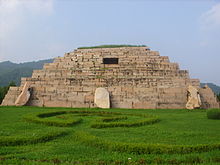 Tomb of the General, presumed to be the tomb of a great Goguryeo king or military official. Located in Jian, China.
Tomb of the General, presumed to be the tomb of a great Goguryeo king or military official. Located in Jian, China.
Three Kingdoms Period mortuary architecture was monumental in scale. For example, in Goguryeo two different types of mortuary architecture evolved during this period: one type of burial is a stepped pyramid made of stone, while another is a large earth mound form. The Cheonmachong mounded burial is an example of the monumental style of mortuary architecture in the ancient Silla capital at Gyeongju.
Murals in tombs dating from Koguryo also reveal a great deal about the architecture of that period as many of them depict buildings which have pillars with entasis. Many have capitals on top of them. The murals reveal that the wooden bracket structures and coloring on the timbers, all characteristic of later Korean structures, were already in use at that time.
Korea also has a rich architectural heritage of tombs and town-wall construction. The brick tomb of King Muryong (501–523 CE) is remarkable for its vaulted ceiling and arch construction.
-
Goguryeo tombs, fifth century, Jian, China.
-
Hwangnam Great Tomb, a double-mounded tomb for a king and queen of Silla.
-
Royal tombs of Bihwa Gaya.
Unified Silla Dynasty (668-935) architecture
Religious architecture
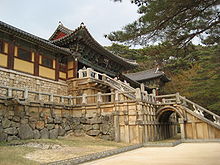 Bulguk Temple, a UNESCO World Heritage Site.
Bulguk Temple, a UNESCO World Heritage Site.
The plans of Buddhist temples were characterized by two pagodas in front of the central main hall in a symmetrical layout on the north-south axis with other buildings. Bulguksa Temple, built on a stone platform at the foothill of Mt. Toham near Gyeongju, is the oldest existing temple in Korea. The temple was first founded early in the sixth century and was entirely rebuilt and enlarged in 752. The original platform and foundations have remained intact to the present, but the existing wooden buildings were reconstructed during the Joseon dynasty.
The stone work of the two-story platform exhibits a superb sense of architectural organization and advanced building methods. Two stone pagodas stand in front of the main hall of the temple. The simpler Seokgatap located to the left of the court represents Buddha's manifestation in a transcendent calm. It has three stories with two pedestal layers and a total height reaching about twenty-five feet. The pagoda consists of simple undecorated pedestal slabs and three-story stupa each of which has five stepped eaves and truncated roofs. These characteristics constitute a typical form of the Korean stone pagodas.
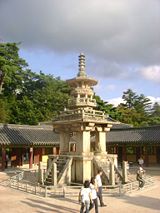 Dabo Pagoda, a national treasure of South Korea.
Dabo Pagoda, a national treasure of South Korea.
To the right of the court, the complex Dabotap represents Buddha's manifestation in a diversified universe, and is unique in Korea, further so in Asia. With a height of thirty-five feet, this pagoda has one pedestal with a staircase on each side, four main stories with balustrade and is characterized by the final crown-ball-and-plate sequence. The design motif of the lotus flower is apparent in mouldings and other details of the pagoda.
The rock cave shrine of Seokguram is located on the crest of Mt. Toham. It was built by the same master architect of Bulguksa Temple, and built around the same era. This cave shrine was artificially and skillfully constructed with granite blocks and covered with an earth mound on top to give the appearance of a natural landscape. The shrine boasts a rectangular anteroom lined with large stone slabs carved with the figures of the protectors of Buddhism on each side of the walls and at the entrance passageway to the main chamber. The circular main chamber covered by an elegant dome ceiling and surrounded by carved stone wall panels depicting bodhisattvas and the ten disciples. The graceful statue of Buddha on a lotus pedestal in the center is the dominant feature of the chamber.
Rock cave shrines are not rare in Asia, but few of these shrines and sculptures reveal such high level of artistry. None are as religiously and artistically complete in overall design as those at Seokguram
-
Granite memorial stupa carved in the shape of an eight-sided roof, National Museum of Korea.
Royal architecture
United Silla architecture is defined as from the 7th century to the 10th century. After the unification of the Korean peninsula into the kingdom of United Silla, Korean institutions were radically transformed. United Silla absorbed the fully matured culture of the Tang dynasty in China, and at the same time developed a unique cultural identity. New Buddhist sects were introduced from the T'ang and Buddhist art flourished. It was a period of peace and cultural advancement in all fields of the arts.
Architecture flourished in the royal capital of Gyeongju, though almost all traces of the former glory have vanished at the present time. The city had nearly 200,000 inhabitants at its peak, and was strategically located at the junction of two rivers and three mountains that encircle a fertile basin of about 170 km² in area. The urban area of the city was developed and expanded in three stages. In the second stage, when Hwangnyongsa Temple was located in the center, the region was developed into a grid network of road patterns with wide streets.
One of the Palace sites is marked by the artificial lake of Anapji with stone works of retaining walls delineating the former building location. The residential district of the nobles in the city was composed of great houses which were constructed conforming to the building code that granted privileges to the nobles, but forbidden to the commoners. Tiles from many ruins of the buildings were found everywhere. Of those that are still intact, show elegant and graceful design.
-
Details of wooden construction reconstructed from archaeological remains recoved from a dredging of Anapji pond. Gyeongju National Museum.
-
Details of wooden construction reconstructed from archaeological remains recoved from a dredging of Anapji pond. Gyeongju National Museum.
Goryeo Dynasty (918-1392) architecture
Goryeo architecture is defined as the period between the 10th century and the 14th century. Much of the architecture in this period was related to religion and influenced by political power/ kingdom. Many buildings such as magnificent Buddhist temples and pagodas were developed based on the religious needs as Buddhism played an important role in the culture and society at the time. It is unfortunate that little has survived to the present day since most of the architecture from this period was built of wood. Also, the capital of Goryeo dynasty was based in Gaesong, a city in modern day North Korea. Its location has made it difficult for many historians in South Korea to study and analyze the architecture of this era.
Few remaining wooden structures from the late "Goryeo" period in South Korea show us significantly simpler bracketing than those from the "Joseon" period architecture. Bright and soft coloring of the structures had been further developed since the Three Kingdoms era.[5]
Joseon Dynasty (1392-1910) architecture
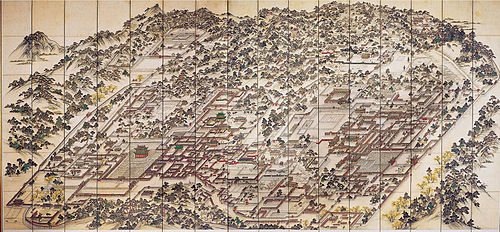 Donggwoldo, a landscape of the once extensive grounds of Changdeok Palace, a UNESCO World Heritage Site and Changgyeong Palace. Painted circa 1830.
Donggwoldo, a landscape of the once extensive grounds of Changdeok Palace, a UNESCO World Heritage Site and Changgyeong Palace. Painted circa 1830.
Joseon architecture is defined as from the 14th century to the 19th century. The founding of the Joseon dynasty in 1392 brought to power like-minded men steeped in the doctrines of Neo-Confucianism, which had slowly percolated into Korea from China in the 14th century. This ushered in a new environment that was relatively hostile to Buddhism, causing the state to gradually shift its patronage from Buddhist temples to Confucian institutions. Throughout the early dynasty, the impetus to reform society along Neo-Confucian lines led to the construction of hyanggyo (local schools) in Seoul and numerous provincial cities. Here, sons of the aristrocracy prepared for civil service careers in an atmosphere of Confucian learning. Although these institutions endured through the end of the dynasty, they began to fall out of favor in the mid-16th century for a variety of reasons. Among these, the rise in population made it the prospects of a civil service career less likely than in earlier years. Also, as the yangban aristocracy matured in its understanding of Neo-Confucianism, they grew more selective in the quality and type of instruction they favored for their sons. As a result, private confucian academies (seowon) gradually supplanted hyanggyos and became a staple of rural aristocratic life until the end of the dynasty.
Neo-Confucianism inspired new architectural paradigms. Jaesil, or clan memorial halls, became common in many villages where extended families erected facilities for common veneration of a distant ancestor. Jongryo, or memorial shrines, were established by the government to commemorate exceptional acts of filial piety or devotion. Even beyond these archetypes, the aesthetics of Neo-Confucianism, which favored practicality, frugality, and harmony with nature, forged a consistent architectural style throughout Korean society.
The most famous town walls are those of Seoul and Suwon. The capital's stone wall, constructed in 1396 and rebuilt in 1422, was sixteen kilometers long (only traces remain today) and had eight gates (including Namtaemun, the South Gate); Suwon's town wall, completed in 1796, was a model of construction methods in Asia at that time, as it benefited from Western influence and techniques.
Fortress architecture
-
Hwa Fortress, a UNESCO World Heritage Site.
-
Choksuk pavilion, Jinju fortress wall.
Religious architecture
-
Temple of Heaven, a site where Korean Emperors performed the rites to Heaven.
-
Jongmyo, a UNESCO World Heritage site. This Confucian shrine is dedicated to the ancestors of the Joseon Dynasty kings.
-
Mireukjeon or Maitreya Hall of Geumsan Temple, a rare three-tiered structure. A Buddhist temple.
-
Gakhwangjeon Hall of the Buddhist temple Hwaeomsa.
-
Gakhwangjeon Hall of the Buddhist temple Hwaeomsa.
-
Rare wooden pagoda on the grounds of Beopju Temple. A Buddhist temple.
-
Daeung Hall of Tongdo Temple rebuilt in 1645, a national treasure of Korea. A Buddhist temple.
Royal architecture
-
Gwangwha Gate, the main gate of Gyeongbok Palace.
-
Royal Library in the grounds of the Secret Garden in Changdeok Palace, a UNESCO World Heritage Site.
-
Honghwa Gate, Changgyeong Palace. Rebuilt in 1616, it is one of the oldest serviving wooden gates in Korea.
Urban architecture
Traditional architecture
-
Commoner homes at Hahoe Folk Village, a UNESCO World Heritage Site.
Colonial period architecture
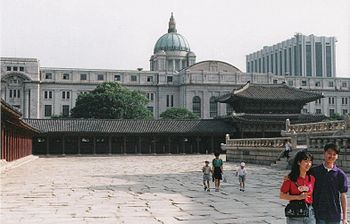 Governor-General of Korea building in front of Gyeongbokgung,which was demolished between 1995 and 1996.
Governor-General of Korea building in front of Gyeongbokgung,which was demolished between 1995 and 1996.
During the colonial era, there was a systematic attempt by the Japanese government to destroy native or traditional Korean architecture and replace it with Japanese architecture[6]. Significant elements of landscaping, such as traditional Korean gardens, were razed, with important artistic pieces sold or taken to Japan, even to the extent of ancient bunjae trees taken for replanting in Japanese bonsai gardens. Also at this period, the construction of traditional religious(Buddhist) architecture was discouraged. One of the ways in which the Korean people resisted the Japanese Nationalist Agenda and Colonialism was to build traditional Korean homes. The houses in Jeonju Hanok Village are a particularly notable example of this. They were erected as a statement of national pride and they remain so today.[7]
Japanese architecture or the infrastructure-building in Korea as part of its colonization plans was first introduced in the Korean transportation networks. Railroad lines saw the construction of Japanese-style rail stations and hotels. Ports as transit points, however, had limited construction. Inland, the Japanese built new city halls, barracks and military bases, jail and prisons, police stations, and police boxes. Having prohibited the teaching of the Korean language in schools, Japan built many new schools along with Japanese educational models. Korean architectural schools were subsequently closed, and Korean architects were required to train only in Japan and encouraged to design exclusively following Japanese models or styles when they returned. While the assumption was that Western influences on Japanese architects would have been transferred to Korea, this did not happen.
Materials for building construction were in short supply, with the Japanese logging and shipping almost all old-growth forests and particularly large cypress logs to Japan, at the same time taking many other building materials of use for their use. This ruthless execution of systematic colonialism left important Korean buildings neglected, and the deterioration of much of architecturally significant examples in Korean architecture history was inevitable. It is needless to say that the new architectural development in Korea is limited to the colonial purposes. Some of historic buildings were also decorated using Japanese ornamentation methods.
The colonial rule didn't allow European cultural influences in Korea as well. In Korea in a period spanning about 35 years, there were no influences from Art Nouveau, Art Deco, Bauhaus, or Style Moderne. Architectural influences from Western culture didn't emgerge until when the post-war period of American architecture and Modernist architecture found its way in Korea, the example of which would be skyscrapers, business/ corporate architecture, and large-scale apartment building developments.
Modern architecture
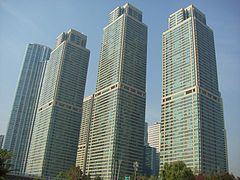 Condominiums in South Korea.
Condominiums in South Korea.
Post-war period and Korean War architecture
After the Surrender of Japan in 1945, American architecture assumed supremacy. Under Douglas MacArthur, who set Korean domestic and political policy from the Supreme Command of the Allied Powers headquarters in Tokyo. Korean architecture by Koreans began once again in domestic areas, with extensive repair of the missionary churches being given priority funding. Essential repair to infrastructure followed, more patch-work than new projects, and block-built hospitals, schools, industries began simple construction under military supervision.
Seoul had survived much of World War II but during the Korean War (1950–1953), many buildings were destroyed, with the city changing command between North Korean and South Korean powers five times. Street-to-street fighting and artillery barrages levelled much of the city, as well as the bridges over the Han River. Important architectural sites were over-run and burnt by invading armies, looting was extensive, and the urban landscape suffered with little money for repairs.
With the armistice, and distinct architectural styles determined by foreign governments began a long period of development.
In the north, Stalinist and absolutist, often brutalist architecture, was championed. North Korean architects studied in Moscow or Soviet satellites, and brought back socialist worker styles and huge celebratory people's architecture on a grand and massively impressive scale. Nomenclatura lived in Soviet-style apartment blocks, farmers and rural workers lived in traditional houses as they always had; urbanization did not occur. Grand buildings and huge public squares were developed in Pyongyang as architectural showpieces. Formal processional landscapes accompanied these sites. Nearly all architecture was government sponsored, and maintained great homogeneity of function and style.
In the south, American models defined all new Korean buildings of any importance, with domestic architecture both civil and rural keeping to traditional buildings, building techniques, and using local materials, and local vernacular styles. The pragmatic need to rebuild a country devastated by genocide, then a civil war, led to ad hoc buildings with no particular styles, extended repeatedly, and a factory system of simple cheap expendable buildings. As few Korean cities had a grid-system, and were often given limits by mountains, few if any urban landscapes had a sense of distinction; by the mid-1950s, rural areas were underfunded, urban areas overfilled, and urban sprawl began with little money to build distinctive important buildings.
Buildings tended to be built quickly with little regard for local identity. As the need for housing for workers increased, traditional hanok villages were razed, hundreds of simple cheap apartments were put up very fast, and bedroom communities on the periphery of the urban centres grew, built and financed as company housing.
Modern Architecture
-
Northeast Asia Trade Tower, Incheon, South Korea.jpg
Northeast Asia Trade Tower, Incheon, South Korea.
Sports architecture
South Korea was selected to host the 1986 Asian Games and the 1988 Olympic games, which spurred waves of new building activity. To market the country globally, international architects were encouraged to submit designs, introducing alternative concepts for modern architecture that began to put style and form ahead of spartan practicality. Historically, sports architecture has occupied the most money and the greatest expression of form identity within Korea. Hundreds of billions of won have been spent on defining Korea as a sports mecca with the architecture leading the way.
Most of the largest projects in the South, as in the North, were government sponsored works: but instead worked in confined, rather than open spaces, and worked with huge amounts of enclosed space, primarily in the state subsidized hugely expensive sports architecture. Korea since the 1980s had its most notable architectural works driven by sports: the Asian Games (1986), the Olympics (1988), and the 2002 World Cup stadium, as well as great support being given by the chaebols such as the Samsung Group which itself owned the sports teams for marketing purposes.
Important architects at this time and their works, often led by the atelier-style architectural co-operative Space Group of Korea, were:
- Park Kil-ryong
- Jungup Kim or Kim Chung-up - Trained in France and designed the Olympic Memorial Gate/World Peace Gate, 1988.
- Jongseong Kim - Weight Lifting Gymnasium, Olympic Park, 1986.
- Kim Swoo Geun who trained in Tokyo - Olympic Stadium. 1984. Total area is 133,649metres³, 100,000seats, 245×180m diameter, 830m in perimeter.
- Kyu Sung Woo - Olympic Village, 1984.
Post-modern Korean architecture
 Hyundai I'Park Tower.
Hyundai I'Park Tower. Jongno Tower.
Jongno Tower.
It wasn't until the late 1980s and early 1990s that an entirely new generation of Korean architects had the freedom and the financing to build Korean architecture in a distinct Korean manner. This was a result of architects studying and training in Europe, Canada, and even in South America, and seeing the need for more of a sense of unique style, and more sophisticated materials. There was a new determination that nationalistic architectural elements had to be revived and refined. Buildings had to mean something within their cultural context.
Post-modern Korean architecture is defined as from 1986 to 2005. Cultural and museum buildings have followed; with city halls and buildings for the civil service appearing generally in a New York/Chicago style rather than following London or Paris trends.
Individuality and experimentation became the new cause for young architects, however the country as a whole was slow to move from the old traditions into seeing good architecture aesthetics as being important to the sense of a village, town, or city. Change was forced at times against intense resistance, and new buildings evolved at great cost to the architects and builders and within a great tension.
Much of the growth of new architecture came from retail stores, clothing shops, bistros, cafes, and bars; and the underside of architectural commissions, rather than from major government contracts or the financial and corporate community. Foreign corporations setting up Korean headquarters also brought in an entirely new spirit of architecture to define their own visions.
Important architects at this time include:
Architectural entity Work Um Tok-mun Sejong Cultural Centre Kim Seok-Chul Seoul Arts Centre Korean Architects Collaborative International under the guidance of Fentress Architects Incheon International Airport See also
References
- ^ a b c d e Jipjari [House]. In Hanguk Gogohak Sajeon [Dictionary of Korean Archaeology], edited by National Research Institute of Cultural Heritage, Seoul, 2001, pp.1130-1131.
- ^ a b c http://www.asianinfo.org/asianinfo/korea/arc/prehistoric_period.htm
- ^ Seongdong-ri Jibjari [The Seongdong-ri Settlement Site]. In Hanguk Gogohak Sajeon [Dictionary of Korean Archaeology], edited by National Research Institute of Cultural Heritage, Seoul, 2001, pp. 652-653.
- ^ Siji-dong Yujeok [The Siji-dong Site]. In Hanguk Gogohak Sajeon [Dictionary of Korean Archaeology], edited by National Research Institute of Cultural Heritage, Seoul, 2001, pp. 749-751.
- ^ Dancheong
- ^ Peter Bartholomew, 'Choson Dynasty Royal Compounds: Windows to a Lost Culture', in Transactions: Royal Asiatic Society, Korea Branch Vol. 68 (Seoul: RAS, 1993)
- ^ Hanok hotels become a hip choice
Further reading
- Fletcher, Banister; Cruickshank, Dan, Sir Banister Fletcher's a History of Architecture, Architectural Press, 20th edition, 1996 (first published 1896). ISBN 0750622679. Cf. Part Four, Chapter 25.
- Sung-woo Kim: Buddhist Architecture of Korea , Hollym Publishers 2007, ISBN 9781565912267.
External links
- History of Korean architecture by Shin Young-hoon
- A Brief History of Korean Architecture
- ENHR Conference report by Jun, N.I., Hong, H.O. and Professor Yang on Japan's occupation architecture in Korea
- Korean contemporary buildings and cityscapes shown to indicate changes
- Korea Society Podcast: New Trends in Korean Architecture with Doojin Hwang
- Korea Society Podcast: How Did Korea Become a Land of Apartments?
- The Herbert Offen Research Collection of the Phillips Library at the Peabody Essex Museum
Architecture of Asia Sovereign
states- Afghanistan
- Armenia
- Azerbaijan
- Bahrain
- Bangladesh
- Bhutan
- Brunei
- Burma (Myanmar)
- Cambodia
- People's Republic of China
- Cyprus
- East Timor (Timor-Leste)
- Egypt
- Georgia
- India
- Indonesia
- Iran
- Iraq
- Israel
- Japan
- Jordan
- Kazakhstan
- North Korea
- South Korea
- Kuwait
- Kyrgyzstan
- Laos
- Lebanon
- Malaysia
- Maldives
- Mongolia
- Nepal
- Oman
- Pakistan
- Philippines
- Qatar
- Russia
- Saudi Arabia
- Singapore
- Sri Lanka
- Syria
- Tajikistan
- Thailand
- Turkey
- Turkmenistan
- United Arab Emirates
- Uzbekistan
- Vietnam
- Yemen
States with limited
recognition- Abkhazia
- Nagorno-Karabakh
- Northern Cyprus
- Palestine
- Republic of China (Taiwan)
- South Ossetia
Dependencies and
other territories- Christmas Island
- Cocos (Keeling) Islands
- Hong Kong
- Macau
Categories:
Wikimedia Foundation. 2010.

